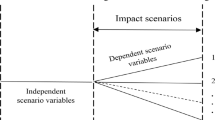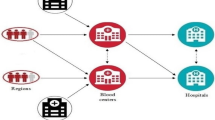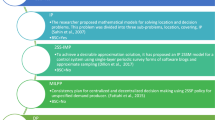Abstract
In a natural disaster such as an earthquake, very often due to the extensive number of severe injuries, demands for blood units sharply increase in emergency hospitals. Regarding such a problem, we propose a new robust two-stage multi-period stochastic model for the blood supply network design with the consideration of a possible natural disaster. The demand for blood units from different types and their derivatives including plasma and platelets are uncertain variables. As a novel contribution, the possibility of transfusion of one blood type as well as its derivatives to other types based on the medical requirements is considered in the optimization model. The pertinent network consists of three layers including the donated areas, the collection blood centers, and the transfusion blood center, which is usually a governmental organization. The model is also constructed for considering a likely earthquake in Tehran (the capital of Islamic Republic of Iran) using a professional report prepared in the year 1999 and also updated in a next research work. The scenarios for the demands of blood units and their derivatives are generated based on these reports. The mathematical model is implemented and assessed in a proper way using the simulation method.




Similar content being viewed by others
References
Abolghasemi, H., Radfar, M. H., Tabatabaee, M., Hosseini-Divkolayee, N. S., & Burkle, F. M. (2008). Revisiting blood transfusion preparedness: Experience from the Bam earthquake response. Prehospital and Disaster Medicine, 23(05), 391–394.
Aghezzaf, E. H., Sitompul, C., & Najid, N. M. (2010). Models for robust tactical planning in multi-stage production systems with uncertain demands. Computers & Operations Research, 37(5), 880–889.
Alem, D., Clark, A., & Moreno, A. (2016). Stochastic network models for logistics planning in disaster relief. European Journal of Operational Research, 255(1), 187–206.
Barbarosoglu, G., & Arda, Y. (2004). A two-stage stochastic programming framework for transportation planning in disaster response. Journal of the Operational Research Society, 55(1), 43–53.
Beliën, J., & Forcé, H. (2012). Supply chain management of blood products: A literature review. European Journal of Operational Research, 217(1), 1–16.
Birge, J. R., & Louveaux, F. (2011). Introduction to stochastic programming. London: Springer.
Bozorgi-Amiri, A., Jabalameli, M. S., & Mirzapour Al-e-Hashem, S. M. (2013). A multi-objective robust stochastic programming model for disaster relief logistics under uncertainty. OR Spectrum, 35(4), 1–29.
Brito Junior, I., Leiras, A., & Yoshizaki, H. (2013). Stochastic optimization applied to the pre-positioning of disaster relief supplies decisions in Brazil. In Proceedings of the 24th annual conference of the production and operations management society (POMS) (pp. 1–10).
Cetin, E., & Sarul, L. S. (2009). A blood bank location model: A multiobjective approach. European Journal of Pure and Applied Mathematics, 2(1), 112–124.
De Rosa, V., Gebhard, M., Hartmann, E., & Wollenweber, J. (2013). Robust sustainable bi-directional logistics network design under uncertainty. International Journal of Production Economics, 145(1), 184–198.
Delen, D., Erraguntla, M., Mayer, R. J., & Wu, C. N. (2011). Better management of blood supply-chain with GIS-based analytics. Annals of Operations Research, 185(1), 181–193.
Esmaeilikia, M., Fahimnia, B., Sarkis, J., Govindan, K., Kumar, A., & Mo, J. (2014). Tactical supply chain planning models with inherent flexibility: Definition and review. Annals of Operations Research, 244(2), 1–21.
Fahimnia, B., Jabbarzadeh, A., Ghavamifar, A., & Bell, M. (2015). Supply chain design for efficient and effective blood supply in disasters. International Journal of Production Economics, 183, 700–709.
Golmohammadi, M., & Mahootchi, M. (2016). Developing a new stochastic model considering bi-directional relations in a natural disaster: A real case study in Tehran (the capital of Islamic Republic of Iran) (pp. 346–352), submitted to Annals of Operation Research, under revision.
Gunpinar, S. (2013). Supply chain optimization of blood products. Ph.D. Dissertation, University of South Florida, 2013.
Hess, J. R., & Thomas, M. J. G. (2003). Blood use in war and disaster: Lessons from the past century. Transfusion, 43(11), 1622–1633.
Hoyos, M. C., Morales, R. S., & Akhavan-Tabatabaei, R. (2015). OR models with stochastic components in disaster operations management: A literature survey. Computers & Industrial Engineering, 82, 183–197.
Jabbarzadeh, A., Fahimnia, B., & Seuring, S. (2014). Dynamic supply chain network design for the supply of blood in disasters: A robust model with real world application. Transportation Research Part E: Logistics and Transportation Review, 70, 225–244.
Kiakalayeh, A. D., Paridar, M., & Toogeh, G. H. (2012). Cost unit analysis of blood transfusion centers in Guilan province. Science Journal of Iranian Blood Transfusion Organization, 9(3).
Manopiniwes, W., & Irohara, T. (2017). Stochastic optimization model for integrated decisions on relief supply chains: Preparedness for disaster response. International Journal of Production Research, 55(4), 979–996.
Melo, M. T., Nickel, S., & Saldanha-da-Gama, F. (2009). Facility location and supply chain management: A review. European Journal of Operational Research, 196(2), 401–412.
Mete, H. O., & Zabinsky, Z. B. (2010). Stochastic optimization of medical supply location and distribution in disaster management. International Journal of Production Economics, 126(1), 76–84.
Mulvey, J. M., Vanderbei, R. J., & Zenios, S. A. (1995). Robust optimization of large-scale systems. Operations Research, 43(2), 264–281.
Nagurney, A., & Masoumi, A. H. (2012). Supply chain network design of a sustainable blood banking system. In Sustainable supply chains (pp. 49–72). New York: Springer.
Nagurney, A., Masoumi, A. H., & Yu, M. (2012). Supply chain network operations management of a blood banking system with cost and risk minimization. Computational Management Science, 9(2), 205–231.
Overstreet, R. E., Hall, D., Hanna, J. B., & Kelly Rainer, R, Jr. (2011). Research in humanitarian logistics. Journal of Humanitarian Logistics and Supply Chain Management, 1(2), 114–131.
Pishvaee, M. S., Razmi, J., & Torabi, S. A. (2012). Robust possibilistic programming for socially responsible supply chain network design: A new approach. Fuzzy Sets and Systems, 206, 1–20.
Rabinowitz, M. (1973). Blood bank inventory policies: A computer simulation. Health Services Research, 8(4), 271.
Ruan, J. H., Wang, X. P., Chan, F. T. S., & Shi, Y. (2016). Optimizing the intermodal transportation of emergency medical supplies using balanced fuzzy clustering. International Journal of Production Research, 54(14), 4368–4386.
Şahin, G., Süral, H., & Meral, S. (2007). Locational analysis for regionalization of Turkish Red Crescent blood services. Computers & Operations Research, 34(3), 692–704.
Salmerón, J., & Apte, A. (2010). Stochastic optimization for natural disaster asset prepositioning. Production and Operations Management, 19(5), 561–574.
Sha, Y., & Huang, J. (2012). The multi-period location-allocation problem of engineering emergency blood supply systems. Systems Engineering Procedia, 5, 21–28.
Tabatabaie, M., Ardalan, A., Abolghasemi, H., Naieni, K. H., Pourmalek, F., Ahmadi, B., et al. (2010). Estimating blood transfusion requirements in preparation for a major earthquake: The Tehran, Iran study. Prehospital and Disaster Medicine, 25(03), 246–252.
Toyasaki, F., & Wakolbinger, T. (2014). Impacts of earmarked private donations for disaster fundraising. Annals of Operations Research, 221(1), 427–447.
Trifunac, M. D., & Brady, A. G. (1975). A study on the duration of strong earthquake ground motion. Bulletin of the Seismological Society of America, 65(3), 581–626. doi: 10.1016/j.ijpe.2015.11.007.
Wang, X., Wu, Y., Liang, L., & Huang, Z. (2016). Service outsourcing and disaster response methods in a relief supply chain. Annals of Operations Research, 240(2), 471–487.
Williamson, L. M., & Devine, D. V. (2013). Challenges in the management of the blood supply. The Lancet, 381(9880), 1866–1875.
Yadavalli, V. S., Sundar, D. K., & Udayabaskaran, S. (2015). Two substitutable perishable product disaster inventory systems. Annals of Operations Research, 233(1), 517–534.
Yang, F., Yuan, Q., Du, S., & Liang, L. (2016). Reserving relief supplies for earthquake: A multi-attribute decision making of China Red Cross. Annals of Operations Research, 247(2), 759–785.
Yu, C. S., & Li, H. L. (2000). A robust optimization model for stochastic logistic problems. International Journal of Production Economics, 64(1), 385–397.
Author information
Authors and Affiliations
Corresponding author
Rights and permissions
About this article
Cite this article
Salehi, F., Mahootchi, M. & Husseini, S.M.M. Developing a robust stochastic model for designing a blood supply chain network in a crisis: a possible earthquake in Tehran. Ann Oper Res 283, 679–703 (2019). https://doi.org/10.1007/s10479-017-2533-0
Published:
Issue Date:
DOI: https://doi.org/10.1007/s10479-017-2533-0




